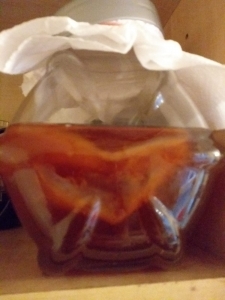Ok, I am finally getting around to doing this. Scoby-lena time! Many of my friends have asked me about Kombucha and how to brew it. I have given some SCOBYs out to people who now need to know what to do… so the easiest is to write it all up in one place 😉
First of all, what on earth is a SCOBY?
It is a Symbiotic Culture Of Bacteria and Yeast (SCOBY) i.e good things for your digestion and it looks like a thick rubbery mass. It is what aids the fermentation process by turning sweet tea into Kombucha.
A SCOBY can look strange and a bit different (they can vary in their looks too), but typically it they are a dense and round creamy coloured mass. It floats in the jar and will take the shape of your vessel. Which means if you put it into a bucket or a bathtub it would grow to that size! No need for that though, a Kilner 1 – 2L size jar will be plenty of room and plenty of Kombucha for you.
Now, what about a Scoby-lena? That’s just what I call my SCOBYs 😊 because I am a nerd.
So now you know what the SCOBY is, what do you do with it?
You use it to make Kombucha, a fermented beverage that has been enjoyed for many years and has powerful health benefits. There are lots of options on the market but brewing it yourself is much cheaper and will contain less sugar than the bought varieties. Now, some would say Kombucha has a unique flavour, and it does, but the cool thing is you can make it as sweet or sour as you want by changing the amount of sugar you add. It is all about getting it to suit your taste, but a bit more on that later on.
Kombucha is produced by adding a SCOBY into sweetened tea (your tea needs to be caffinated but not perfumed, so no Earl Grey! – English Breakfast or Green Tea is the best choice). You then let it ferment for 6-10 days and this will vary on the room temperature. The more you do it the more you will understand when it is ready. The bacteria and yeast in the SCOBY break down the sugary tea and convert it into alcohol, carbon dioxide and acids. Don’t worry the alcohol content is very low. The fermentation process increases the probiotics content, so good for your gut.
NOTE: It is important not to let you SCOBY come into contact with metal, so when making your tea put it in a container that can take the heat and remove any jewellery like rings when handling the SCOBY.



For a standard SCOBY brew, a ratio of 3 tea bags and a cup of sugar (just standard sugar, no fancy stuff) will be about right. I use measuring cups for my sugar. You can add more sugar if you want it sweeter but do not put less as then your SCOBY won’t have anything to feed on.
Remove the tea bags after an hour of brewing and continue to let the tea cool down. Once the tea is cold, you can add this to your SCOBY jar (big Kilner jars are great for this) and then cover with a coffee filter, double layered kitchen roll or muslin cloth. Your cloth needs to be breathable but not allow flies to get in, and they will try to get in!
NOTE: do not add the tea when hot as the heat can kill the SCOBY, the tea must be cool before adding it.
Once covered leave the SCOBY jar away from direct sunlight and at room temperature. The temperature will speed up or slow down the fermentation process so depending where you are, this may be a bit fast / slow for you. So keep an eye on the jar and when the liquid lightens it is time to decant the brewed Kombucha. After it has fermented for about six days, you can start tasting it (use a plastic spoon, not metal!) and you’ll know it’s done when it tastes good to you. That should be not too sweet but not too tart.
It’s really all about your preference but it should be complete within six to 10 days. If you leave it a bit longer, it is not the end of the world. You may not want to drink it though but I have made some fun vinegars from overbrewed Kombucha. Will discuss this more in a future post.
NOTE: Have the next sweetened tea ready before decanting, so the SCOBY is always in liquid. It is also important to leave a bit of the old mixture in your main SCOBY brew jar so that the good bacteria and yeast stays with the SCOBY. I leave about an inch and a half to two inches in my jar, as in the one pictured.
Once you decanted the mixture out, you can flavour it up. I use honey to sweeten (only at this stage not the brew! that has to be standard sugar) and depending on what else I am putting in for flavour you will want to add more or less honey. So if you are using fruits in your Kombucha brew, use less sweetner as the fruits themselves will have some sweetness they will add. Again though by experimenting you will learn what suits you best. Some of my favourite flavours are:
Chilli; Ginger; Strawberry and basil; Passionfruit; Blackberry and cinnamon; but have a go making your own combos and let me know what flavours you are loving the most!


Because the SCOBY continues to grow with each batch of kombucha, once the SCOBY is about 1/4 inch (2/3-cm) thick, you can use it to brew a new batch of kombucha or give it to a friend so they can brew.
You also want to have a SCOBY hotel in case something goes wrong with yours, that way you have a back up! I will write more up myself in the future but for now here are some resources below have lots and lots of info and where I learnt all about brewing!
Other resources and Kombucha tips:
https://www.greenmatters.com/p/what-is-scoby-kombucha
https://happykombucga.co.uk/pages/kombuch-frequently-asked-questions









Leave A Comment